When creating presentations and slideshows, images are one of the most reliable resources for clearly providing information to your viewers. Images are easy to edit, produce, and sync across cloud services. With that in mind, learning how to create a slideshow in Google Photos with music is a valuable skill, thanks to the rich file-syncing properties of Google accounts. In this article, we provide a detailed guide on creating slideshows on Google Photos, utilizing two of the most popular options available within the service. We will also introduce some useful tips for slideshow production and an alternative tool for making video slideshows on Windows and Mac.

Google Photos is the cloud-based gallery service by Google, specifically designed for photo backup on smartphones with the app installed. Apart from file backup, the software offers other practical features, including a dedicated photo slideshow maker, which will be the main focus of our article.
Since the slideshow maker feature is only a bonus offering within the software, most of its editing and production capabilities are limited. It only offers the ability to add music, adjust the aspect ratio, and edit the duration of each slide.
With these features in mind, Google Photos is generally recommended only for users who want to create basic slideshows and presentations. To learn how to create these projects within the software, please read the guides provided below, which feature two of the easiest options for creating slideshows in Google Photos.
Best Used For: Creating a thematic slideshow of an album with similar images, subjects, or themes.
1. Open Google Photos on your browser and locate the Album tab. There, select the album you want to create a slideshow of.

2. Inside the Album you selected, click the Three-Dot option on the upper right side of the menu.

In the drop-down menu that will appear, select Slideshow.

3. After clicking on Slideshow, the album will now be viewed as a slideshow in full-screen mode. You may now use your keyboard’s direction keys to move through the images.

If you wish to learn how to make a slideshow with Google Photos, you are in luck, since this is the easiest option for creating presentations in Google Photos. It also helps that it eliminates the need to select multiple images one by one.
Limitations: Album slideshows do not offer Google Photo Editor and customizable options. It will only arrange all the images in a slideshow, which you can easily present.
Best Used For: Applying music and editing the aspect ratio of the slideshow you are creating.
1. Open Google Photos and then select the Create (Plus Sign) option from the upper menu of the website. Then, select Highlight Video from the drop-down menu that appears.
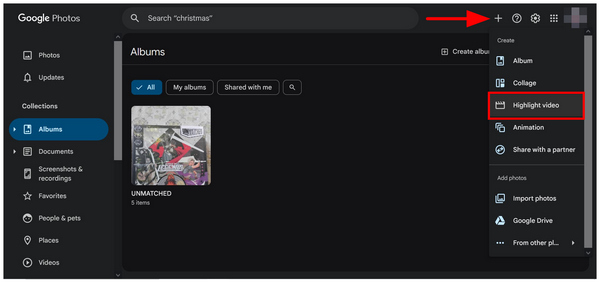
2. In the Create Video tab, click Create Your Own Video to select images one by one. Another option is to use the Search Bar to look for an album or specific images saved in Google Photos.
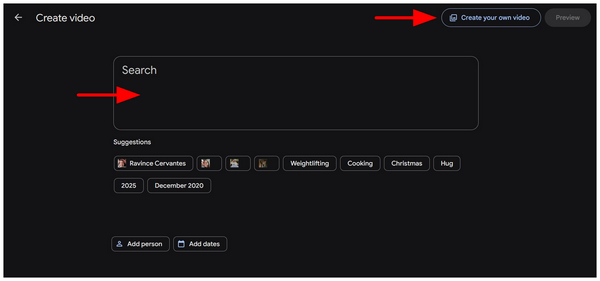
In this tutorial, we will use the Search Bar function to select the album we used from the first method. Select all the images in the identified album, then click on Create to proceed to the Highlight Video editor.
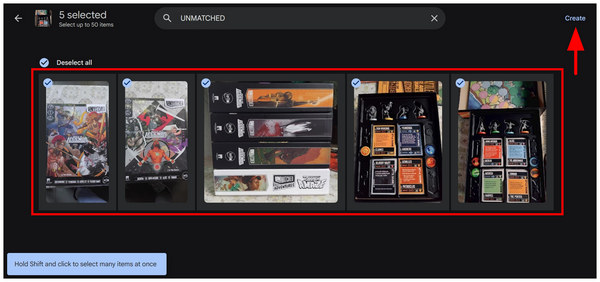
3. In the Highlight Video editor, you can now edit the images you have selected for the video slideshow. You can click on the Music or Aspect Ratio button to adjust these elements in the video. To edit the duration of each image in the slideshow, edit the Adjustable Bar on the right side of the editing window. Once you are satisfied with the adjustments, select Save to create the Google Photos slideshow video.

Due to the presence of the music input in Google Photos, learning how to make a slideshow with music from Google Photos is possible and very easy. However, you cannot apply audio to regular slideshows, but only to slideshows from video maker presentations.
Limitations: Limited editing options are available for both the entire video slideshow and individual images.
When creating slideshows, ensure that the album you select has image files with no more than 50 photos. This is essential to maintain smooth playback, as exceeding the 50-image threshold results in a significant performance reduction for the slideshow that will be created.
To ensure that your slideshow looks good, your images should follow a clear theme or be in chronological order. This will ensure that your intended audience can understand the message your slideshow aims to convey.
If you think that a single image lacks proper context to be understood, you may add short captions that are well-written to give context to your viewers. This will greatly improve the contextual value of your presentation.
Now that we have discussed the slideshow-making capabilities of Google Photos, the lack of essential editing features is its most apparent issue. With that in mind, using an alternative that provides these lacking features is essential. In this case, consider using AnyMP4 Video Converter Ultimate.
Available for both Windows and Mac operating systems, this multimedia editing tool features a dedicated MV Maker function designed to easily create video projects, such as slideshows. This was made possible by the presence of beginner-friendly editing templates, including video effects, themes, filters, and background audio tracks. Notably, these editing tools are not present in Google Photos.
In addition to these practical editing tools, AnyMP4 Video Converter Ultimate supports over 500 media formats, including popular file types such as MP4, MOV, WMV, AVI, MKV, and GIF.
To learn more about what makes AnyMP4 Video Converter Ultimate’s MV Maker feature a good option slideshow maker, make sure to read the software’s main features below.
Recommendation
For an easier time following the tutorial below, we highly recommend downloading AnyMP4 Video Converter Ultimate using the provided link to learn how to produce slideshows with the software.
Secure Download
Secure Download
1. Open AnyMP4 Video Converter Ultimate, then go to the MV Maker tab among the options from the software’s upper menu. Then, click on Add file button to import the images you want to add to the slideshow.
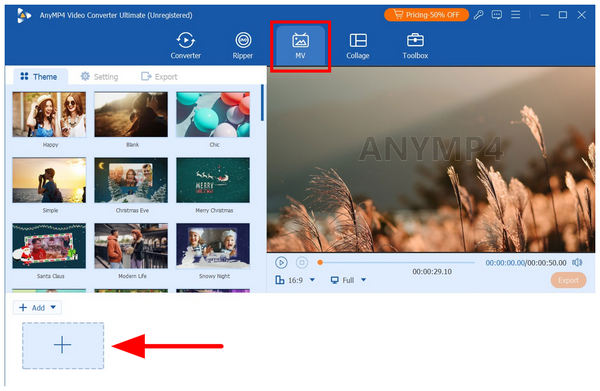
2. Now that the image files for the slideshow are imported into the MV Maker editor, you can use the following tools to edit each image: Edit, Trim, or Order Adjustment. To adjust each image’s Effects, Filters, and Color, select the Edit option.

3. After applying the editing tools to each media, proceed to the Export tab. There, you can edit output parameters such as the Format, Frame Rate, Resolution, and Quality. Once these elements are adjusted, click on Start Export to confirm your adjustments and continue producing the slideshow video.
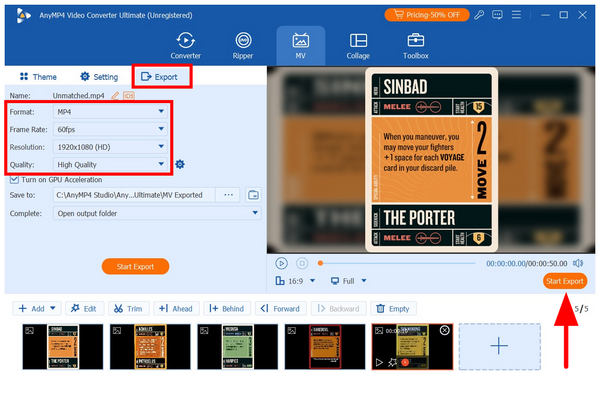
Although Google Photos technically works as a slideshow creator, the severe lack of editing tools for the images you will use hinders it from becoming a reliable option. This makes third-party alternatives a much more recommended software if you wish to produce high-quality slideshows.
Can I add music or transitions to a Google Photos slideshow?
Yes, you may. You can make a Google Photos slideshow with music. However, custom transitions are not available in its slideshow creator.
Is Google Photos slideshow free to use?
Yes, it is. Google Photos comes for free when you create your Google account. However, using it is optional or only needed when you need to back up or recover Google Photos images.
How do I share a Google Photos slideshow with others?
Yes, you can. However, only slideshow videos can be shared online or through a link. Regular slideshows may only be shared if you share the link of an album, and then the receiver uses the Slideshow option.
Can I download a slideshow from Google Photos?
Yes, you can. However, this is only possible if you create a slideshow video. Regular slideshows from albums cannot be downloaded.
Is Google Photos’ slideshow maker a good option?
It depends on your needs. If you only wish to use a barebones slideshow that functions, it may be enough. However, it is not recommended for more advanced presentations due to the limited editing tools available in the program.
Now that we have provided an overview of using Google Photos to create slideshows, we hope this article has provided you with the vital information you need to use the online gallery to create presentations from your own images. Otherwise, we recommend using a more advanced editing tool, such as AnyMP4 Video Converter Ultimate, to create higher-quality video slideshows. You may download the alternative using the download link below.
Secure Download
Secure Download